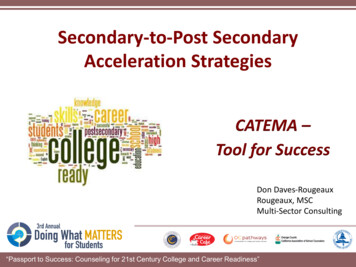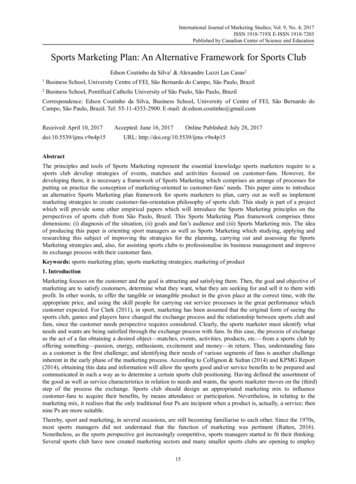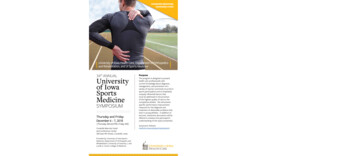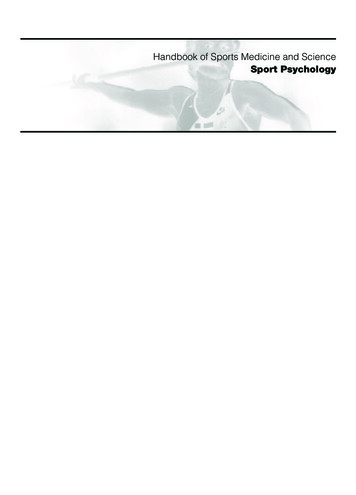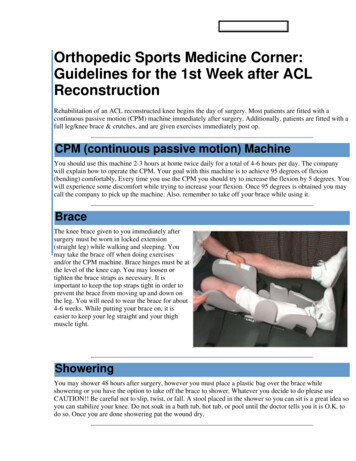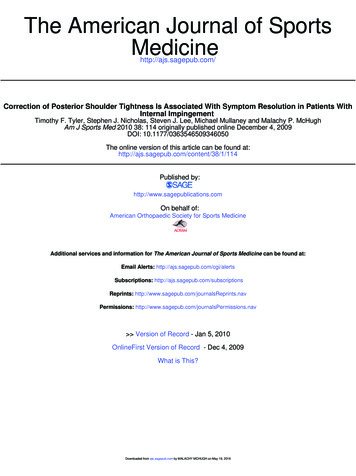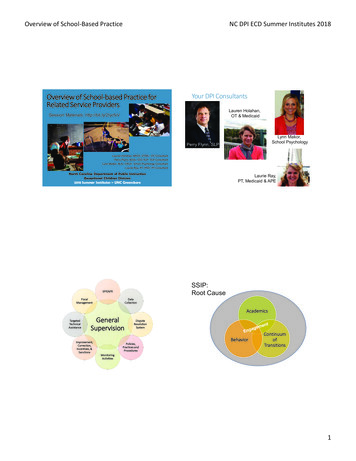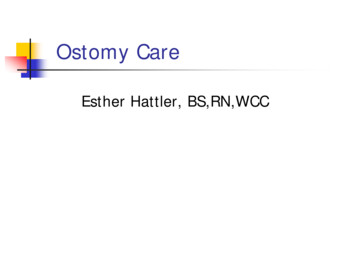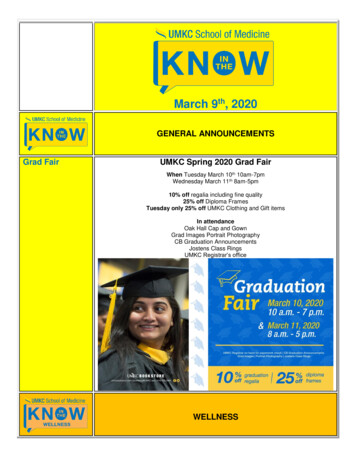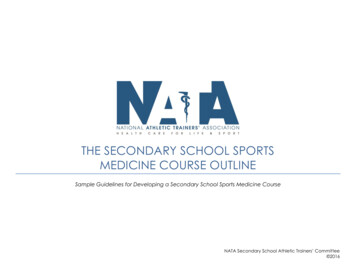
Transcription
THE SECONDARY SCHOOL SPORTSMEDICINE COURSE OUTLINESample Guidelines for Developing a Secondary School Sports Medicine CourseNATA Secondary School Athletic Trainers’ Committee 2016
THE SECONDARY SCHOOL SPORTS MEDICINE COURSE OUTLINEDisclaimer of LiabilityThe materials and information provided in the National Athletic Trainers’ Association (“NATA”) “Secondary School Sports MedicineCourse Outline” (the “Outline”) are educational in nature, and the Outline is published as a resource for NATA members and isintended solely for personal use/reference in the manner described herein.NATA has taken reasonable efforts to ensure that all materials included in the Outline are accurate and consistent with standards ofgood practice in the general athletic trainers’ industry. As research and practice advance, however, standards may change. For thisreason, it is recommended that NATA members evaluate the applicability of any materials included in the Outline in light of particularsituations and changing standards.By accessing this Outline, NATA members agree to use it appropriately and within applicable state laws regarding athletic traininglicensure and/or regulation. Improper use of the Outline, including without limitation, allowing students or other unlicensed orunqualified individuals to perform functions of a medical professional, or to otherwise engage in the practice of athletic training, are aviolation of the relevant state practice act, the NATA Official Statement on Proper Supervision of Secondary School Student Aides, aswell as the NATA Code of Ethics Principles 2.2 and 2.3, as set forth below.NATA Code of Ethics 2.2 Members shall be familiar with and abide by all National Athletic Trainers’ Association standards, rules and regulations. 2.3 Members shall report illegal or unethical practices related to athletic training to the appropriate person or authority.In no event shall the National Athletic Trainers’ Association, its directors, officers, or employees be held liable for any losses, injury,damages, or any other consequences resulting from, or arising in connection with, the use or reliance on any materials provided in oraccessed via the Outline. By accessing the Outline, all NATA members who make use of the Outline agree to indemnify, defend andhold harmless the National Athletic Trainers’ Association, its directors, officers, or employees, from and against any and all losses, costs,expenses, claims, damages and liabilities related to or associated with the NATA member’s use of the Outline, including but not limitedto any and all losses, costs, expenses, claims, damages and liabilities arising from or related to the improper use of the Outline. Byaccessing the Outline, all NATA members who make use of the Outline agree to abide by applicable state laws, and NATA standards,rules and regulations regarding the lawful practice of athletic training.NATA Secondary School Athletic Trainers’ Committee 2016
THE SECONDARY SCHOOL SPORTS MEDICINE COURSE OUTLINESample Guidelines for Developing a Secondary School Sports Medicine CourseThis guide is an outline/template for a secondary school sports medicine course. It provides a list of ideas that are approved by theNational Athletic Trainers’ Association (NATA) Secondary School Athletic Trainers’ Committee (SSATC) that an individual may pick andchoose from. Athletic trainers (ATs) who utilize this template to teach a sports medicine courses must review their state practice acts toensure their final curriculum does not violate state rules or regulations.DEVELOPED BY THE SECONDARY SCHOOL ATHLETIC TRAINERS’ COMMITTEE:Larry Cooper, MS, ATC, LAT, ChairBart Peterson, MSS, ATC, Incoming ChairDenise Alosa, MS, ATCCasey Christy, ATCGeorge Wham, EdD, ATC, SCATDale Grooms, ATCDan Newman, MS, ATC, LATKembra Mathis, MEd, ATC, LATLisa Walker, ATCStacey Ritter, MS, ATCChris Snoddy, ATC, LATChris Dean, ATCCari Wood, ATC, NATA BOD LiaisonAmanda Muscatell, NATA Staff LiaisonA SPECIAL THANKS TO THE SECONDARY SCHOOL SPORTS MEDICINE COURSE OUTLINE SUBCOMMITTEE:Larry Cooper, MS, ATC, LAT, ChairKembra Mathis, MEd, ATC, LATGeorge Wham, EdD, ATC, SCATDan Newman, MS, ATC, LATBart Peterson, MSS, ATC, Incoming ChairIN MEMORIAM:We would like to acknowledge the lasting impact of David McAllister, fellow athletic trainer, husband, father and friend. David wasinstrumental during the beginning stages of this project and the SSATC was honored to complete the Secondary School SportsMedicine Course Outline in his memory.NATA Secondary School Athletic Trainers’ Committee 2016
FOUNDATIONS OF SPORTS MEDICINE ICourse Description: This course provides high school students with a general overview of athletic training, sports medicine and itshistory. It includes introductory information about the AT’s scope of practice: injury prevention, treatment, rehabilitation, emergencyinjury management and administrative functions. This course is intended to help students gain an understanding of sports medicine,various associated disciplines and the role they play in the physically active community. Students enrolled in this class will not providepatient care.Unit 1 Investigating the Field of Sports MedicineOrganizational and Professional Health and Well-Being Terms: athletic training student aides, licensed athletic trainer (LAT), athletic trainer certified (ATC), National Athletic Trainers’Association (NATA), Board of Certification (BOC), accrediting agencies, state board, American Medical Association (AMA), sportsmedicine, sports medicine team, National Federation of State High School Associations (NFHS) Objectives-Students will be able to: 1.1 Describe the historical foundations of athletic training. 1.2 Compare and contrast various professional organizations dedicated to athletic training and sports medicine. 1.3 Delineate the process for attaining national certification and state licensure for the athletic trainer. 1.4 List and differentiate between the roles and responsibilities of other health care professionals who make up the sportsmedicine team (e.g., physicians, physical therapists, occupational therapists, nurses, EMTs, etc.). 1.5 Analyze the different types of job opportunities and settings available to the athletic trainer as well as other members ofthe sports medicine team. Applications-Activities students may perform: Draw a timeline and give brief explanations of the significance that specific past events have on the present, as well as inferpossible implications those events may have on the profession’s future. Create a scenario involving a minimum of five members of the sports medicine team and explain how they work together. Pick 5 states, locate their practice acts and determine the process required to be able to practice athletic training orphysical therapy in each state. How is each different or the same? Discussion on the sports medicine team and all its members. This can include: physicians, athletic trainers, personal trainers,massage therapists, physician assistants, nurse practitioners, physical therapists, sports psychologists, nutritionist, dentists,chiropractors, nurses, exercise physiologists, biomechanists, strength and conditioning coaches, emergency medicaltechnicians, paramedics, orthotists and prosthetists.Unit 2 Understanding Concepts of Health Care AdministrationOrganizational and Professional Health and Well-BeingNATA Secondary School Athletic Trainers’ Committee 2016
Terms: Health Insurance Portability and Accountability Act (HIPAA), Family Education Right and Protection Act (FERPA), sports medicinefacility, WOTSUP (weaknesses, opportunities, treats, strengths, underline, planning), preparticipation physical examination (PPE), injurytracking, SOAP (subjective, objective, assessment, plan) note Objectives-Students will be able to: 2.1 Investigate the necessary components that make up a well-designed sports medicine facility. 2.2 List budgetary concerns. 2.3 Explain the legal importance of accurate, clear and up-to-date record keeping. 2.4 Create and analyze legal scenarios to consider as an administrator of an athletic health care facility in different settings. 2.5 Explain the difference between HIPAA and FERPA in relation to sharing medical information. Applications-Activities students may perform: Create a list of equipment necessary to run a sports medicine facility on a certain budget. Design a sports medicine facility with a certain budget in mind. Determine the software you will use for injury tracking andpick 3 vendors/distributors to buy the equipment from.Unit 3 Analyzing Legal, Ethical and Insurance Considerations in Sports MedicineOrganizational and Professional Health and Well-Being Terms: duty, liability, negligence (tort), assumption of risk, sovereign immunity, good Samaritan law, product liability, statute oflimitations, foreseeability of harm, practice act, general medical insurance, liability insurance, HMO, PPO, Medicare, Medicaid,billing codes (ICD, CPT), third party reimbursement, copay, premium, deductible, SOAP note, National Provider Identifiers (NPIs) Objectives-Students will be able to: 3.1 List and define the 4 components of negligence. 3.2 Analyze legal considerations for health care professionals. 3.3 Compare and contrast legal concepts of liability, negligence, supervision, and assumption of risks. 3.4 Differentiate between legal and ethical actions in a given scenario. 3.5 Differentiate between different types of medical insurance and be able to explain various terms associated with thirdparty reimbursement. 3.6 Determine the benefits of maintaining medical records to benefit the student athletes. 3.7 Discuss the importance of medical professionals obtaining National Provider Identifiers (NPIs) Applications-Activities students may perform: Locate a recent lawsuit involving a sports medicine health care professional and create a mock trial. Examine real-world scenarios of specific legal and ethical dilemmas related to sports medicine and analyze them. Discuss ways in which health care professionals can reduce their liability risk when working with student-athletes.NATA Secondary School Athletic Trainers’ Committee 2016
Unit 4 Understanding the Basics of Training and Conditioning TechniquesTreatment and Rehabilitation Terms: cardiac output, overload principle, domains of fitness, training effect, aerobic metabolism, anaerobic metabolism,adenosine tri phosphate (ATP), creatine phosphate (CP), neuromuscular control (NMC), range of motion (ROM), plyometric,proprioception, muscle spindle, golgi tendon organ (GTO), functional progression, agonist muscle, antagonist muscle,proprioceptive neuromuscular facilitation (PNF), DOMS, DAPRE, isometric, isotonic Objectives-Students will be able to: 4.1 Investigate the roles of the athletic trainer and the strength and conditioning coach on an athlete’s fitness. 4.2 Explain the principles of conditioning. 4.3 Explain the role that overtraining plays in the risk of injury. 4.4 Design goals of a training and conditioning program for a specific sport/position on a team. 4.5 List the equipment needed for a comprehensive training and conditioning program. 4.6 Differentiate between the types of stretching and determine which is best in a given scenario. Applications-Activities students may perform: Design a workout program for a specific sport using each of the following techniques/principles: dynamic, static, and PNFstretching; PREs, isometrics, isotonics, core stability and proprioception exercises. Design a workout for a hypothetical scenario. Discuss how technology has helped to motivate people to exercise.Unit 5 Assessing Environmental Factors That Lead to InjuryImmediate and Emergency Care Terms: emergency action plan (EAP), thermal injuries, ambient temperature, heat index, psychrometer, wind chill, humidity,conduction, convection, evaporation, radiation, hydration, altitude, sun protection factor (SPF), circadian dysrhythmia, sicklecell trait, lightning and thunder. Objectives-Students will be able to: 5.1 Recognize atmospheric conditions that contribute to environmental injury. 5.2 Explain the environmental factors to be considered when caring for athletes. 5.3 Determine an appropriate SPF for specific individuals. 5.4 Explain the complications circadian dysrhythmia could have for various levels of athletes. 5.5 Discuss the importance of an EAP and policy for thunder and lightning as it relates to athletics. 5.6 Determine the risks associated with repeated overexposure to the sun. Applications-Activities students may perform: Formulate the wet-bulb globe temperature (WBGT) using a sling psychrometer or other means and make suggestions for safepractice in given scenarios.NATA Secondary School Athletic Trainers’ Committee 2016
Create the thunder and lightning EAP for a specific outdoor venue.Investigate equipment necessary to prevent, manage and treat environmental injury/illnesses.Explain the role of the each member of the sports medicine team.Discuss as many ways as possible to decrease the risk of environmental injuries.Unit 6 Human Anatomy and Physiology: Discussion on the Following Body S ystems 6.1 Integumentary 6.2 Skeletal 6.3 Nervous 6.4 Cardiovascular 6.5 Endocrine 6.6 Muscular 6.7 Lymphatic 6.8 Respiratory 6.9 Urinary 6.10 Excretory 6.11 Reproductive 6.12 Digestive 6.13 ImmuneUnit 7 Understanding Basic Taping, Wrapping and Bracing for InjuriesInjury/Illness Prevention and Wellness Protection Terms: off- the-shelf, customized, foam padding, orthotics, prophylactic taping, bracing, restricted movement brace, heel lock,stirrup, horseshoe, spica, spiral Objectives-Students will be able to: 7.1 List considerations to be given when properly fitting headgear. 7.2 Debate the advantages and disadvantages of customized versus commercial protective devices. 7.3 Identify the types of marketed and fabricated bracing devices as well as techniques. 7.4 Debate the advantages and disadvantages of taping versus bracing. 7.5 Determine which elastic wraps and wrapping procedures are most appropriate for specific scenarios. 7.6 Differentiate between different types of adhesive and cohesive tape, and determine what application is best for aspecific scenario 7.7 Identify 4 basic tape applications and the rationale of each. Applications-Activities students may perform:NATA Secondary School Athletic Trainers’ Committee 2016
Demonstrate knowledge of basic wrapping and taping procedures for a given joint.Demonstrate knowledge of basic taping procedures to prevent a specific movement for a given joint.Discuss the different types of athletic tape and their uses.Unit 8 Understanding Sports Nutrition, Supplementation and Substance AbuseInjury/Illness Prevention and Wellness Protection Terms: nutrients, vitamins, minerals, supplements, amino acids, saturated fats, unsaturated fats, electrolytes, calorie, anabolicsteroids, human growth hormone (HGH), body composition, anorexia nervosa, bulimia, creatine, amphetamines, performanceenhancing drugs (PED), banned substance Objectives-Students will be able to: 8.1 List the six classes of nutrients and give an example in each class. 8.2 Explain the importance of good nutrition in enhancing performance and injury prevention. 8.3 Differentiate between body weight and body composition along with the factors that influence both of them. 8.4 Identify methods to calculate percent body fat and issues associated with each. 8.5 Identify safe methods for weight loss as well as weight gain. Applications-Activities students may perform: Create an appropriate pre-game meal for a specific sport (endurance vs. non endurance). Create an educational brochure for athletes on banned substances from the IOC and the NCAA. Study food labels and identify what information is important for people involved in different athletic activities.Unit 9 Identifying Basic Tissue Response and Common InjuriesClinical Evaluation and Diagnosis Terms: inflammation, acute, chronic, edema, hemorrhage, inflammatory response, necrosis, Wolff’s Law, nerve pathway,nociceptors, pain, vascular response, skin lesions, Stress-strain curve, strain, sprain, bursitis, mechanism of injury, micro trauma, macrotrauma, biomechanical alteration, fasciitis, myositis ossificans, hematoma, subluxation, luxation, osteochondral defects, arthritis,epiphysis, fractures (fx), diagnostic imaging techniques Objectives-Students will be able to: 9.1 Describe and illustrate the three phases of the healing process as it pertains to various soft tissue structures, includingcartilage, ligament, muscle, tendon, and nerve. 9.2 Explain the physiology and psychology of pain. 9.3 Differentiate between sprains and strains, and differentiate between 1st, 2nd, and 3rd degree injuries. 9.4 Illustrate various types of fractures and explain the forces required to produce each one. 9.5 List the mechanical properties of tissue as they pertain to the stress-strain curve. 9.6 Illustrate and describe the 5 types of tissue loading.NATA Secondary School Athletic Trainers’ Committee 2016
9.7 Explain the relationship between poor body mechanics and injury potential.Application-Activities students can perform: Provide examples of the types of injuries overtraining may cause for a specific sport. Model and demonstrate components of the stress-strain curve. Discuss ways in which active individuals can decrease their chance of an overuse injury.Unit 10 Recognizing and Preventing the S pread of Blood Borne PathogensImmediate and Emergency care Terms: hepatitis, human immunodeficiency virus (HIV), acquired immune deficiency syndrome (AIDS), Occupational Safety andHealth Administration (OSHA) 10.2 Investigate various blood borne pathogens. 10.3 Explain the OSHA blood borne pathogen standard. 10.4 Outline the components of a written exposure plan. 10.5 Explain basic wound care procedures. Application-Activities students can perform: Demonstrate basic wound care procedures. Demonstrate proper hand washing and glove usage. Discuss the OSHA policy at your school. Identify common mistakes that schools make as it pertains to OSHA guidelines.Unit 11 Determining Appropriate Emergency Injury ManagementInjury/Illness Prevention and Wellness Protection Terms: primary survey, secondary survey, history observation palpation special tests (HOPS), peripheral nervous system (PNS),central nervous system (CNS), level of consciousness (LOC), crepitus, myotome, dermatome, reflexes, concussion, traumatic braininjury (TBI), amnesia, cardiopulmonary resuscitation (CPR), automatic external defibrillator (AED), emergency action plan (EAP),catastrophic injury, myocardial infarction, sudden death syndrome, stroke, embolism, aneurism 11.2 Determine the components of an EAP. 11.3 Investigate the acute injury management techniques. 11.4 List and describe the signs and symptoms of a concussion and demonstrate the recognition of them. 11.5 Explain the steps involved in performing CPR. 11.6 Recognize the common causes of cardiopulmonary complications in sports. Applications-Activities students may perform: Properly demonstrate CPR and the use of an AEDoAttain first aid certificationNATA Secondary School Athletic Trainers’ Committee 2016
oCreate an EAP for a specific sport and venueoDiscuss the importance of involving each member of the sports medicine teamDescribe what is involved in the primary assessmentDescribe what is involved in the secondary assessment (including vital signs)Emergency splinting and bandagingWound careDisaster preparednessEMS system and structureAirway managementCPR/AEDRescue breathingMedical emergencieso Bleeding, shock, soft tissue injurieso Musculoskeletalo Poisoningo BurnsUnit 12 Investigating the Psychological Aspects of InjuryTreatment and Rehabilitation Terms: anxiety, cognitive appraisal model, counselor, imagery, five stages of grief, psychiatrist, psychologist, referral, relaxationtechniques, reactionary phases, psychosis, neurosis, personality disorders, phobias 12.1 Investigate the psychological reactions one may see in the ill or injured athlete. 12.4 Determine the reasons why social support is important to the injured athlete. 12.3 Describe the role a health care provider plays when dealing with various psychological reactions. 12.4 Differentiate between a counselor, a psychologist and a psychiatrist. Applications-Activities students may perform: Create a list of community resources that could be used for intervention. Discuss warning signs of psychological issues such as depression, suicide.NATA Secondary School Athletic Trainers’ Committee 2016
Unit 13 Introduction to Rehabilitation and ModalitiesTreatment and Rehabilitation Terms: cryotherapy, thermotherapy, therapeutic ultrasound, electrical modality, manual therapy, protocol, parameter, indication,contraindication, thermal modality, ground fault circuit interrupter, hydrotherapy, light modality 13.1 List the safety procedures with each type of modality. 13.2 Investigate the role of various rehabilitation professionals. 13.3 Understand the five phases of rehabilitation. Applications-Activities students may perform: Create a first aid treatment plan for an acute injury.Unit 14 Basic PharmacologyTreatment and Rehabilitation Terms: pharmacology, over-the-counter drugs (OTC), nomenclature, nonsteroidal anti-inflammatory drugs (NSAIDs), infectiondeterrents, diuretics, pain relievers, steroids, drug distribution, barbiturates, gastrointestinal, stimulant, cardiac drugs, dispensing,administration, interactions, adverse reaction 14.1 Describe the difference between over the counter medications and prescription medications. 14.2 Discuss the different classifications of common medications. 14.3 Identify safety guidelines associated with proper medication use. 14.4 List socially used drugs and problems associated with athletics and performance. Applications-Activities students may perform: Create a list of common substance that may be used in an athletic health care facility. Identify common mistakes associated with improper administration and dispensing of medication in the athletic health carefacility. Discuss the importance of having EAPs for asthma, allergic reactions, and cardiac arrest.Unit 15 Fundamental Concepts of EvaluationClinical Evaluation Terms: directional terminology, anatomical position, planes of the body, clinical survey, manual muscle testing, culturalconsiderations, active range of motion, passive range of motion, resistive range of motion, HOPS (history, observation, palpation,special tests), SOAP (subjective, objective, assessment, plan) 15.2 Illustrate the “anatomical position.” 15.1 Differentiate between HOPS and SOAP. 15.3 Differentiate between manual muscle testing and resistive range of motion testing. 15.4 Examine cultural differences as it pertains to the manner in which an evaluation is conducted.NATA Secondary School Athletic Trainers’ Committee 2016
Applications-Activities students may perform: Point out various anatomical landmarks for a given body part. Create a SOAP note for a specific injury. Research different videos on specific body part evaluation techniques and terminology. Discuss ethical considerations that may be involved in an injury evaluation (e.g.: patent positioning, witnesses, culturaldifferences).NATA Secondary School Athletic Trainers’ Committee 2016
1.3 Delineate the process for attaining national certification and state licensure for the athletic trainer. 1.4 List and differentiate between the roles and responsibilities of other health care professionals who make up the sports medicine team (e.g., physicians, physical
